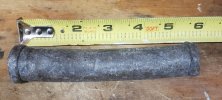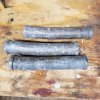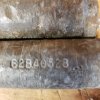You are using an out of date browser. It may not display this or other websites correctly.
You should upgrade or use an alternative browser.
You should upgrade or use an alternative browser.
Mystery bars
- Thread starter TomSp8
- Start date
Every foundry (there are thousands of them) blends their own alloys based on the customer's request. Without knowing the foundry assuming they are even still in business it could be and most likely is anything. Cast some with it before blending with known good alloy and see how hard it is. That is extremely unscientific but could give ya an idea on how usable it is for bullets.
I was hoping based on the shape of them, that might be a clue to someone. I will add them to my "mystery" alloy bin for now. These were in the lot of stuff I originally acquired with my pot, ladle, and other ingots that I've been casting with so far. It is shiny when I scratch it with a razor. Not super soft, but not super hard either.

Snakeoil
Well-Known Member
Interesting shape that seems to be cast in rather than the ends rounded over from using them to hit something. My guess is some type of counterweight. Is there a hole down the center? The shape makes me think they had a mechanical purpose. The number could be a part number as well as an alloy number. Could be there were other sizes with different numbers.
That was my thought as well, that they were cast that shape for a purpose. No hole to attach anything, and they are solid. Oh well, into the mystery bin they go for some other day I reckon.Interesting shape that seems to be cast in rather than the ends rounded over from using them to hit something. My guess is some type of counterweight. Is there a hole down the center? The shape makes me think they had a mechanical purpose. The number could be a part number as well as an alloy number. Could be there were other sizes with different numbers.
Winelover
North Central Arkansas
Like Rick said. Cast a few from a known mould, and compare castability and weight...........if you have no way to definitely check BHN. I don't fret, as long as it behaves like lead. You can always make the castings harder/weigh lighter or softer/weigh more.
There's an old saying................dilution is the solution to pollution. Can extrapolate that to lead, also.
There's an old saying................dilution is the solution to pollution. Can extrapolate that to lead, also.
Snakeoil
Well-Known Member
Could be the ends are like that to keep them from slipping out of a hand. They might have been a weight used to hold something down on an assembly line or some other process. If the company that used them had them made by another company, that would explain the number stamped on them.
There is a magazine called Yankee. They have a section where you can send in a picture of some obscure antique item and they will try to tell you what it is. Worth a shot.
There is a magazine called Yankee. They have a section where you can send in a picture of some obscure antique item and they will try to tell you what it is. Worth a shot.
Missionary
Well-Known Member
Clock weights would have some simple and secure means to connect to a chain or cable.
RBHarter
West Central AR
Those that I've seen up close , real functional pieces , had brass cups with the chain fittings there it's been a long time ago . My wood shop teacher was building an all wood grandfather clock .Clock weights would have some simple and secure means to connect to a chain or cable.
richhodg66
Well-Known Member
There's a good guy on the other site, goes by BNE. Send him a tiny sample and a pound of some kind of casting alloy as payment for the service and he'll put an XRF gun to it and tell you exactly what it is. I've had him do this for me a couple of times, great guy.
Ian
Notorious member
One of them rolled off a bench and landed on a fine-thread bolt at some point. They've had a rough life and I bet more than one life, the last one likely being in someone's shop as non-marring drifts as was mentioned. I could see clock weights for sure if they were installed in a brass canister, but I've never seen them done that way. Sash weights were usually iron and had integral rope eyes cast into them. The part number is the real stumper to me, seems to have been part of something but no idea what.
L Ross
Well-Known Member
In my highly technical scientific method of doing things I'd grab something sorta pointy. Maybe a scratch awl, a screw driver, or my Swiss Army knife. I'd drag it across the surface and feel it. Gummy feeling, soft lead, add some harder lead and make bullets. Kinda skiddy feeling, harder lead, cast bullets as is. Sharp pointy thing doesn't impress it much, go grab a bar of lino and see if the sharp pointy thing feels similar, add soft lead and cast up bullets. I'm with Grinnell on lead.


